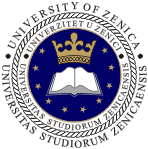CHANGE IN pH AND CONDUCTIVITY DURING THE RINSING AND THE BIOSORPTION OF COPPER IONS ONTO PUMPKIN PEEL
The changes in pH and conductivity during the rinsing of the pumpkin peel, and the biosorption of Cu2+ ions, were the subject of this work. The obtained data showed that the pH value of the solutions increased during the rinsing of the biosorbent, as a result of the transfer of H+ ions from the aqueous phase into the structure of the pumpkin peel. ...
By Marina Marković, Milan Gorgievski, Miljan Marković, Vesna Grekulović, Nada Štrbac, Milica Zdravković, Kristina Božinović
THE CONTENT OF As, Pb AND Cd IN ENVIRONMENTAL SAMPLES IN MUNICIPALITY OF KIJEVO
Toxic metals like arsenic(As), lead (Pb)and cadmium(Cd) are the major indicators of environmental pollution that have serious impact to human health as well as the environment. Measurement of these metals were done in the samples of : selected plants, Željeznica river, and agricultural soil in the municipality of Kijevo near Sarajevo ci...
By Aida Šapčanin, Zahida Begović, Amna Kukić, Farzet Bikić
CHARACTERIZATION OF LIMESTONE AND DOLOMITE FILLERS FOR INDUSTRIAL APPLICATIONS
Fillers play a crucial role in enhancing product performance and reducing production costs. To be used in various industries, fillers must be readily available, affordable, pure, non-toxic, and meet specific physical and chemical standards. This study examines limestone and dolomite fillers, focusing on their chemical composition, mineralogical pro...
By Nedzad Haracic, Nevzet Merdić, Ilhan Bušatlić, Nadira Bušatlić, Adelina Pašalić
SYNTHESIS AND STRUCTURAL ANALYSIS OF HIGH-ENTROPY OXIDE (CoCrFeMnNi)₃O₄
Technological developments and the demand for innovative products in catalysis and energy conversion/storage have driven the development of high entropy alloys (HEAs) and high entropy oxides (HEOs). HEAs, formed by combining four or more elements in nearly equal ratios, and HEOs have become prominent research topics for the above-mentioned technolo...
By Umay Çınarlı Yavaş, Ahmet Turan, Taner Akbay
INFLUENCE OF CORROSION ON MECHANICAL CHARACTERISTICS OF STEEL SAMPLES (42CrMo4)
Specific environmental conditions, such as marine environments, often influence steel applications in marine industries. These conditions are commonly simulated using a NaCl solution in order to simplify the study and eliminate the complexities of seawater's chemical and biological variability. In this study, 42CrMo4 steel samples, a widely utilize...
By Stanica Nedović, Ana Alil, Sanja Martinović, Tatjana Volkov Husović
OPTIMIZING DEMAGNETIZATION PROCESS FOR RECYCLING END-OF-LIFE NdFeB MAGNETS
NdFeB (Neodymium-Iron-Boron) magnets are essential for technologies such as electric vehicles, wind turbines, and medical devices due to their high energy density. However, the growing demand for these magnets, coupled with the limited availability of rare earth elements (REEs), emphasizes the need for efficient recycling of end-of-life (EOL) NdFeB...
By Anıl Umut Özdemir, Umay Çınarlı Yavaş, Taner Akbay, Ahmet Turan
EVALUATION OF PROFEX SOFTWARE FOR PHASE ANALYSIS OF CEMENT, CLINKER, AND LIMESTONE: A COMPARATIVE STUDY WITH TOPAS
X-ray diffraction is a crucial method for characterizing crystalline materials, widely employed in the analysis of both products and raw materials in the cement industry, including clinker, cement, and limestone. Quantitative phase analysis via X-ray diffraction necessitates sophisticated computational tools to accurately interpret diffraction patt...
By Marina Jovanović, Adnan Mujkanovic, Nevzet Merdic, Nedžad Haračić, Vinko Baranašić
SYNERGY BY MOLYBDENUM AND NIOBIUM ON PERFORMANCE OF COLD WORK TOOL STEELS
For die industry where future products have decisive roles for material selection, subject of steel is an area of interest with high potential for innovation. With new production technologies that prioritize knowledge, the quality of materials has improved significantly and these developments continue. Material selection in die design is an impor...
By Aslan UNAL
POSSIBLE IMPACT OF REPLACEMENT OF FOSSIL FUEL IN THE CITY OF ZENICA HEATING SYSTEM ON CADMIUM CONCENTRATION IN THE CITY AIR
The aim of the research conducted in this paper is to analyze the cadmium content in particulate matter PM10 for the period of 2020–2024, and thereby provide a realistic assessment of whether there has been a significant reduction in cadmium emissions into the atmosphere of Zenica due to the replacement of fossil fuels for the city’s he...
By Farzet Bikić, Halim Prcanović, Mirnes Duraković, Naida Bikić, Sanela Beganović
INVESTIGATION OF THE POSSIBILITY OF ENVIRONMENTALLY FRIENDLY PORTLAND-COMPOSITE CEMENT CEM II/C-M (W+LL) PRODUCTION IN THE KAKANJ CEMENT PLANT
Public demand for environmentally friendly solutions for new types of cement with reduced CO₂ emissions is increasing. Consequently, new types of cement must be developed and introduced to the market. This paper presents test results for cement formulations based on calcium fly ash and marly limestone, following the EN 197-5 standard. The clinker c...
By Nevzet Merdić, Nedžad Haračić, Ilhan Bušatlić, Nadira Bušatlić, Adnan Mujkanović, Nedžib Kobilica






